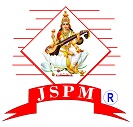Laboratory
Electrical Measurement & Instrumentation Lab
Description:
Our objective is to make the students efficient enough to carry out experiments and projects independently and to achieve the ability to think in an innovative way. The aim of this lab to have hands-on practice of various instruments while studying Electrical Engineering.
Under Electrical Measurement & instrumentation Lab students can perform the experiment related to the subject -Electrical Measurement & instrumentation lab.
Major equipments of lab are:
Three phase variac (440 V, 25 Amp.), Anderson's kit (0-500) mA galvanometer), Kelvin's double bridge (0-500) mA galvanometer), Loading rheostat star or delta.( 3 phase 440 volt 5 Amp), Dual trace sensitivity oscilloscope (30 Mhz, 1MV, 2 channel), Inductive load bank with switch & insulated terminals (3- phase,415 V/ 10 Amp)
Equipments:
LVDT kit, Three phase variac (440 V, 25 Amp.), Anderson's kit ((0-500) mA galvanometer), Kelvin's double bridge((0-500) mA galvanometer) etc , Loading rheostat star or delta.( 3 phase 440 volt 5 Amp), Dual trace sensitivity oscilloscope (30 Mhz, 1MV, 2 channel), Inductive load bank with switch & insulated terminals (3- phase,415 V/ 10 Amp).
Features:
Students can perform the experiments based on:
- Demonstration of working parts of various types of meter.
- Extension of instrument range: ammeter, voltmeter, watt meter using CT & PT.
- Measurement of active & reactive power in three phase circuit using two wattmeter methods (balanced & unbalanced loads)
- Measurement of active & reactive power in three phase balanced circuit using one wattmeter method with two way switch.
- Measurement of voltage, current, time period, frequency & phase angle using CRO.
- Measurement of low resistance using Kelvin's double bridge.
- Measurement of inductance using Anderson's bridge/ Maxwell's bridge
- Measurement of displacement by using LVDT
- Water level measurement
- Calibration of Energy meter
- Measurement of earth resistance and so on.
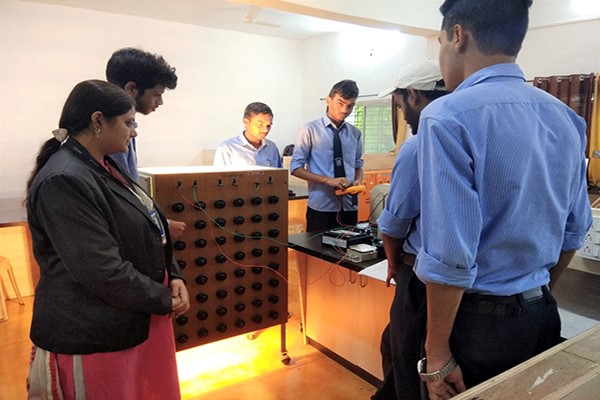
Area of Practical:
1 Electrical Measurement.
2 Instrumentation, Basic Electrical Engineering.
Power Electronics Lab
Description:
Under Power Electronics Lab, students can perform the experiments related to the subject - Analog and Digital Circuits, Network Analysis, Power Electronics and Advance Power Electronics.
Major equipments of lab are:
Dual channel cathode ray oscilloscope, Dual DC regulated power supply, Analog Digital trainer large bread board LCR bank, Analog Digital trainer large bread board LCR bank etc
Features:
Students can perform the experiments based on:
Study of counters, ring counter and twisted ring Counter, Study of up-down counters, Op-amp as ZCD, Comparator and Schmitt trigger, Study of active filters- Low pass and high pass filters, Study of various flip-flops and verification of truth table, Assembly language Programming using 8085 (4 programs minimum based on 8 bit addition, 16 bit addition, multiplication, largest number, smallest number, ascending order, descending order), Interfacing of seven segment LED display with 8085, Static VI characteristic of SCR and TRIAC (Both), Single phase fully controlled converter with R and RL load, Single phase A.C. voltage regulator, VI Characteristic of MOSFET and IGBT (Both), DC step down chopper, Three phase AC-DC fully controlled bridge converter, Three phase voltage source inverter using 1200 and 1800 mode, Study of cascaded type multilevel inverter

Area of Practical:
1 Advance Power Electronics. 2 Analog & Digital Circuits. 3 Network Analysis
Renewable Energy Source Lab
Description:
As renewable energy is the future of the world. By considering that in our department we have set up a separate Renewable Energy Source lab. In this lab students can perform the experiments on wind energy system and solar training system. Where they can perform experiments like measuring wind speed, electricity generation by wind, electricity generation by solar pv etc.
Features:
We have one set up each for wind energy system and solar training system. Both the set ups can be used for research purpose.
Utilization:
UG
Area of Practical:
1 Renewable Energy
2 Power Quality.

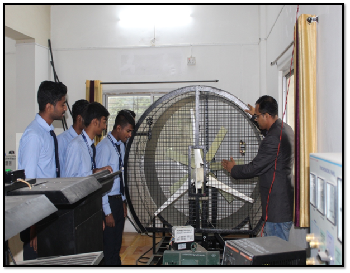
Material Science and High Voltage Lab
Description:
The objective of Material Science and High Voltage laboratory is to understand various properties and characteristics of different classes of materials and To develop ability to test different classes of materials as per IS.
Major equipments of lab are:
High Voltage Transformer upto 100 KVA with Control panel, Sphere Gap Unit, Motorized Oil Testing Equipment of rating 100 KVA, Million Meg Ohm Meter, Hysteresis and BH Curve kit
Features:
Testing of all types of insulating material such as PVC, resins, polymers, Transformer Oil, Air etc under high voltage up to 100KV to check its breakdown strength so as to understand their suitability at various parts of power system. Also Students are able to measure Resistivity of High resistivity alloys, Insulation resistance of Power Capacitor, Flux density by Gauss meter and obtain hysteresis loop for ferromagnetic materials. All high voltage tests are done inside Faraday Cage to ensure safety of all students and staff from any faults or partial discharge.
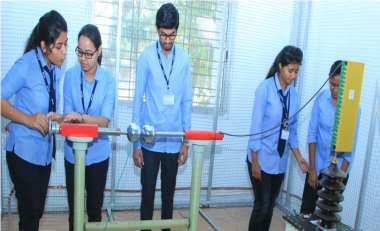
Utilization:
All types of insulating material such as PVC, resins, polymers, Transformer Oil, Air are tested under high voltage up to 100KV to check its breakdown strength so as to understand their suitability at various parts of power system. Also Students are able to measure Resistivity of High resistivity alloys, Insulation resistance of Power Capacitor, Flux density by Gauss meter and obtain hysteresis loop for ferromagnetic materials. All high voltage tests are done inside Faraday Cage to ensure safety of all students and staff from any faults or partial discharge.
Area of Practical:
1 High Voltage
2 Material Science.
Electrical Machine Lab
Description:
The Objective of Electrical Machines Lab is to understand various different types of Electrical Machines such as Motor, Transformer, and Alternator etc. and to perform various tests & speed controls methods on various Electrical Machines to understand behavior of machines for particular application.
Major equipments of lab are:
Three phase variac (440 V, 25 Amp.), Single phase variac (270V, 5 Amp.), LPF & UPF Wattemeters, Three Phase Transformer, Single Phase transformer, Rectifier unit, Loading rheostat star or delta.( 3 phase 440 volt 5 Amp), Inductive load bank with switch & insulated terminals (3- phase,415 V/ 10 Amp), DC Shunt & Series motor, Three Phase Squirrel Cage & Induction motor, Three Phase Alternator coupled to shunt motor, Three Phase synchronous motor.
Utilization:
Area of Utilization -150 Sq Mtr
Area of Practical:
1 Machines I&II. 2 Electrical Technology. 3 Electrical Drives. 4 Circuit. 5 Electrical Circuit Machines.
Features:
Students can perform the experiments based on:
- O.C. and S.C. test on single phase Transformer
- Parallel Operation of two single phase transformer with equal & unequal turns ratio.
- Speed control of D.C. Shunt motor and study of starters.
- Brake test on D.C. Shunt motor
- Load test on D.C Series motor
- Load test on 3-phase induction motor.
- No load & blocked-rotor test on 3-phase induction motor
- Load test on three phase synchronous motor
- Find out voltage regulation of Alternator by EMF method, MMF method, ZPF method
- Find out voltage regulation of Alternator by direct loading test
- V & Inverted V curve of Synchronous motor
- Load test on 1phase induction motor.
- Speed control of three phase induction motor by V/F method
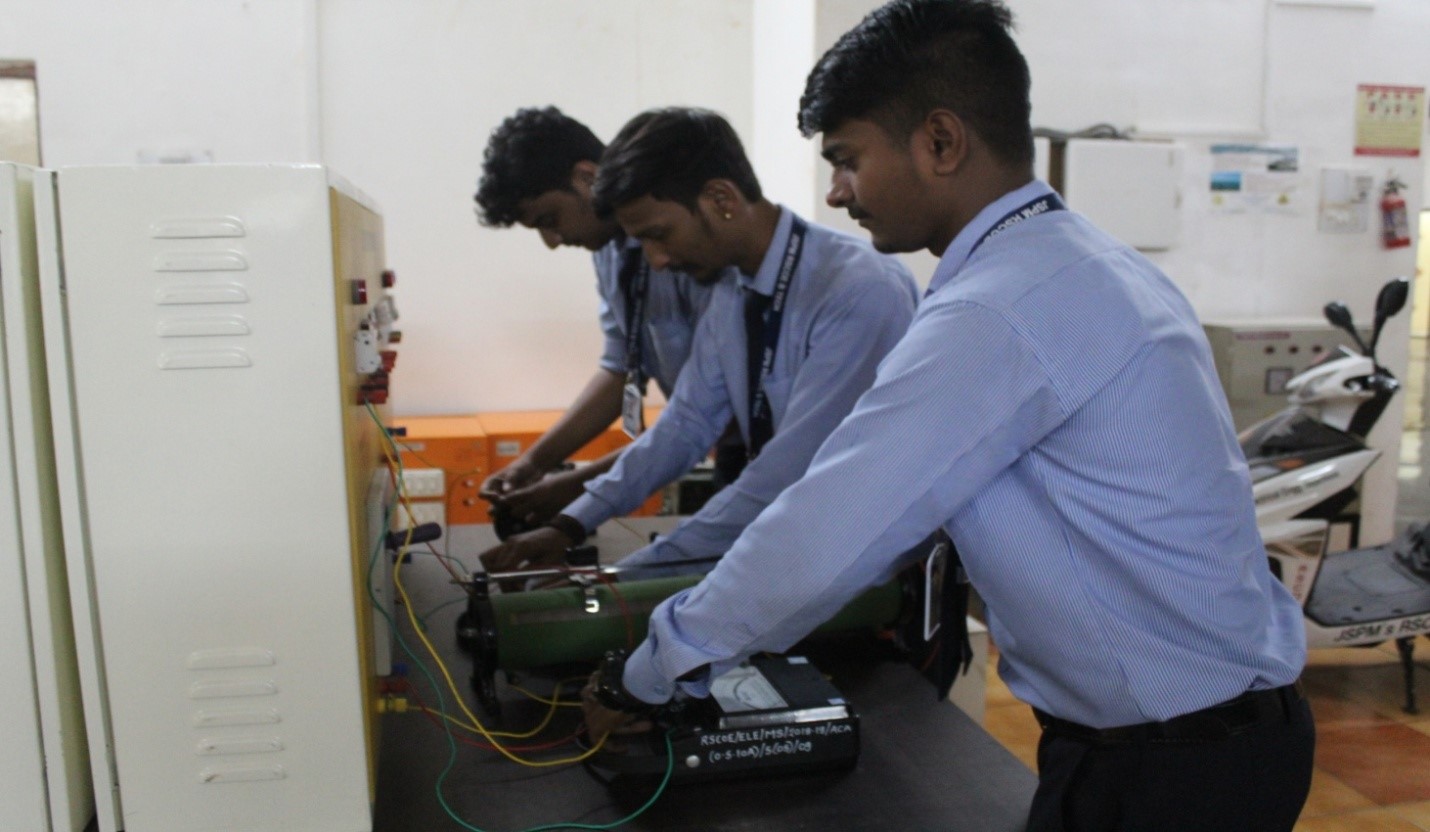
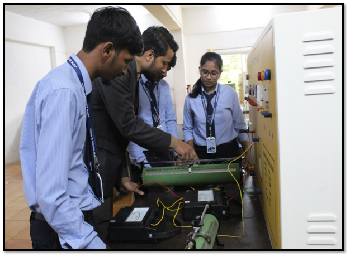
Electrical Control System Lab
Description:
Under Electrical Control system Lab, students can perform the experiment related to the subject – Control system-I (SY), control system-II (TY).
Major equipments of lab are : Digital storage oscilloscope, CRO, Function generator
Features:
Verification of superposition theorem, Thevenin’s theorem, Reciprocity theorem, Millman’s theorem, Determination of parameter of two port network, frequency response on constant K-low pass filter, frequency response on constant K-high pass filter, Determination of time response of R-L-C organise and so on.
Utilization:
Verification of superposition theorem, Thevenin’s theorem, Reciprocity theorem, Millman’s theorem, Determination of parameter of two port network, frequency response on constant K-low pass filter, frequency response on constant K-high pass filter, Determination of time response of R-L-C rganiz and so on....
Area of Practical:
1.Control System. 2.Electrical Technology. 3.Electrical Drives. 4.Circuit. 5.Electrical Circuit Machines.

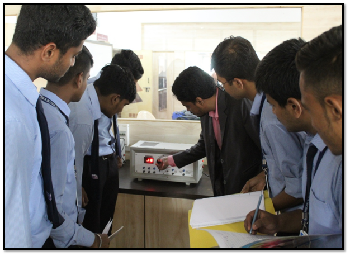
Power System Lab
Description:
Lab is engaged with Power system-II for third year and PSOC for last year students, SGP for last year students. Lab manuals are available for different practical’s conducted in this laboratory. We have maintained dead stock registers which gives details of kits available and transferred kits to other department. Consumable register to update the available and new purchase components required in the lab. We have issue registers to maintain the kits issued to other laboratory or to the students for their projects. Students have facility to utilize all software and kits for their projects. This lab is also utilized for self-learning by students during free slot of lab.
Equipment:
Transmission line kit, capacitor bank, salient-pole alternator, synchronous machine, Computers for simulation.
VCB, ACB, Simulation panel for differential protection of Transformer, Alternator, Induction Motor, Numerical Relay, Relay Testing Kit, and Electromechanical relay etc.
For Switchgear & Protection Lab:
- Relay testing panel, simulation panel of differential protection of transformer, simulation panel of protection schemes of alternator, microprocessor based relay, model of miniature circuit breaker, model of moulded circuit breaker, model of vacuum circuit breaker, air circuit breaker, model of SF6 circuit breaker.
Features:
Power system and Switchgear and Protection Lab used for student’s project purpose & research purpose.
Area of Practical:
1 Switchgear & Protection. 2 Power system.
Utilization:
For Power System Lab:
- Measurement of ABCD parameters of a medium transmission line
- Measurement of ABCD parameters of a long transmission line
- Plotting of receiving end circle diagram to evaluate performance of medium transmission line
- Study of the effect of VAR compensation using capacitor bank.
- Static measurement of sub-transient reactance’s of a salient-pole alternator.
- Measurement of sequence reactance’s of a synchronous machine (Negative and zero)
- Calculation of inductance and capacitance for symmetrical and unsymmetrical configuration of transmission line using a software
- Formulation and calculation of Y- bus matrix of a system
- Solution of a load flow problem using Gauss-Seidal method
- Solution of a load flow problem using Newton-Raphson method
- Symmetrical and Unsymmetrical fault analysis of a 3-bus system
- Simulation of HVDC system.
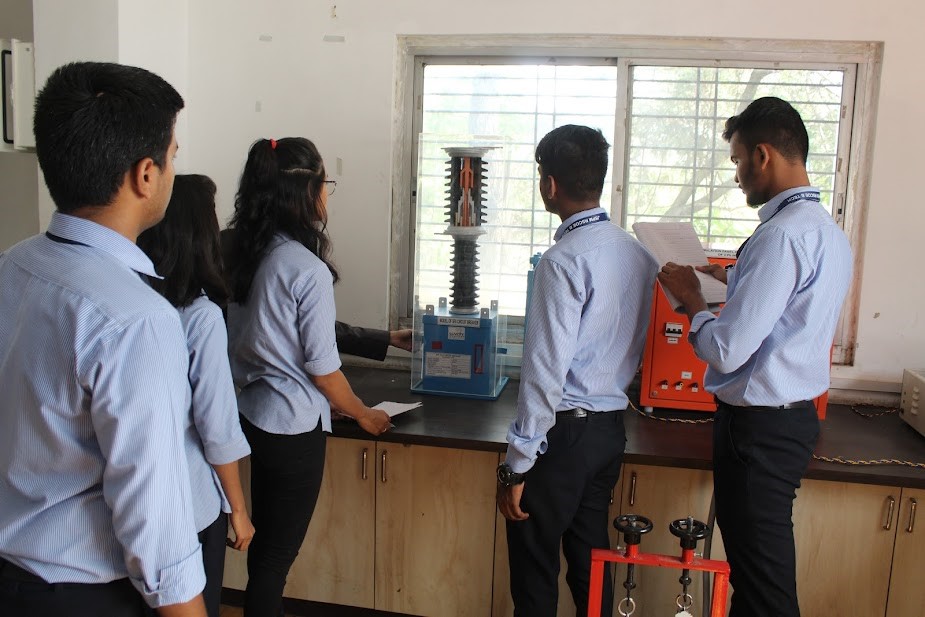
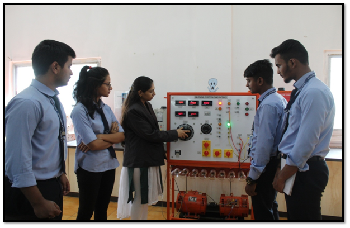
PLC and SCADA Lab
Description:
The PLC laboratory is setup to complement the topics studied in the automation theory course. The lab is equipped with PLC automation trainer kits and modules to enable the study of components of automation system. The students perform experiments to study the components of PLC, programming PLC, interconnection of PLC with computer and SCADA Programming. This lab is very useful for project-based learning.
The purpose of this laboratory is to train the students to be familiar with the software and hardware of PLC so that they can gain enough experiences to meet the demand of the automation era.
Major Equipment:
This lab has various types of PLC along with interfacing modules to demonstrate the detailed applications of PLC and SCADA. Allen Bradley PLC, 24 V DC power supply, Proximity sensors, inductive switches, flow measurement device, Toggle switches, Indicating Lamps, Ethernet Cable, Optical sensors along with PLC trainer Kit. Temperature Control Level control Sequential Switching of motor, Ladder programming software.
Utilization:
PLC and SCADA Lab is one of the well-equipped automation LAB
This lab is utilized for conducting the following course(s):
PLC and SCADA laboratory TY students
Project based learning for SY TY and BE students
Features:
The facilities in the laboratory enable students to build a firm background in PLC hardware as well as software. Students learn about ladder logic programming, wiring different I/O's (analog and digital) with PLC and SCADA programming. They acquire the practical skills sufficient to design and realize basic automation process
Students can perform the experiments based on:
PLC and SCADA Automation:
- A PLC (i.e. Programmable Logic Controller) is a device that was invented to replace the necessary sequential relay circuits for machine control. The PLC works by looking at its inputs and depending upon their state, turning on/off its outputs. The user enters a program, usually via software, that gives the desired results. PLCs are used in many "real world" applications.
- This is widely used in industry for Supervisory Control and Data Acquisition of industrial processes. SCADA systems are now used in the controls of ancillary systems such as cooling, ventilation, power distribution, etc. and have made substantial progress over the recent years in terms of functionality, scalability and performance.
Area of Practical:
1 PLC and Scada. 2 Artificial Intelligence.
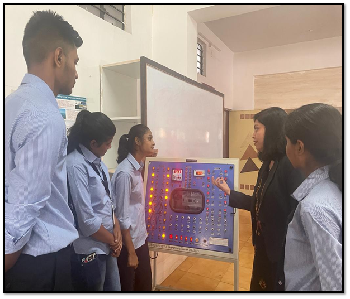
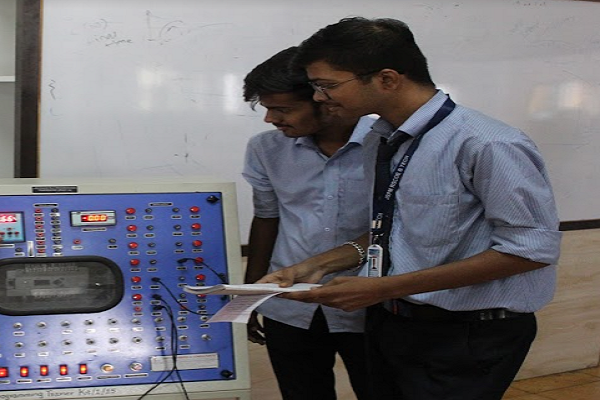
Computer Lab
Description:
The laboratory has seven software these are used by undergraduate students for performing exercises given in various course domains. Final year students exclusively use the software for their project work.
Utilization:
UG/PG
Features:
Students perform practical’s of Operating System based on Windows 7 platform.
Area of Practical:
1 Electrical Machine Design. 2 Microcontroller. 3 Power System Analysis. 4 Power System operation and Control. 5 Numerical Method and Computer Programming.
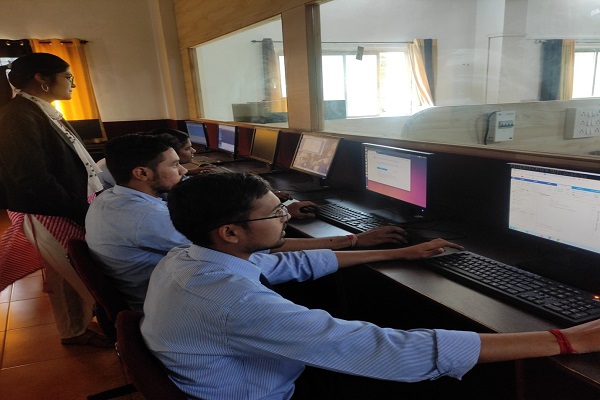
Project Lab
Description:
Projects at third year and final year level are conducted in the lab throughout the year. Supporting hardware and software is available in the lab such as, simulation software, journal paper access and others. Students make use of available systems for conducting their in-house projects.
